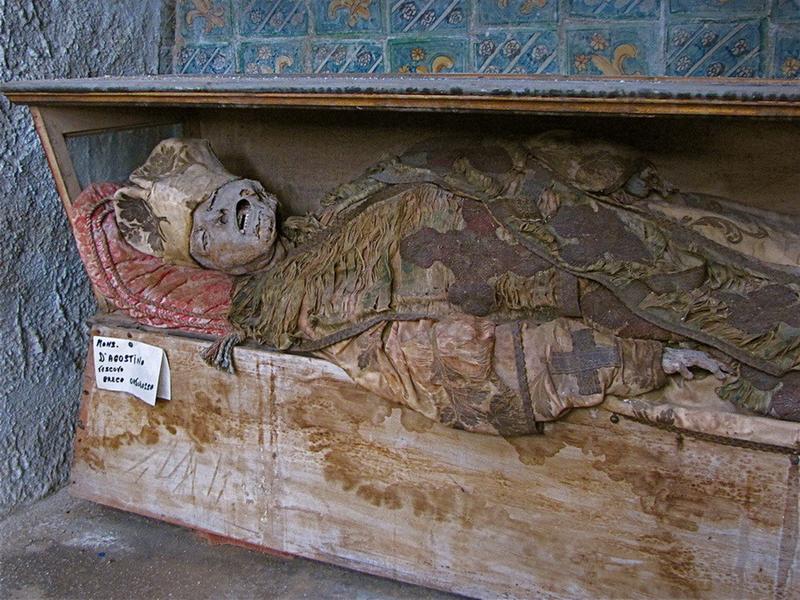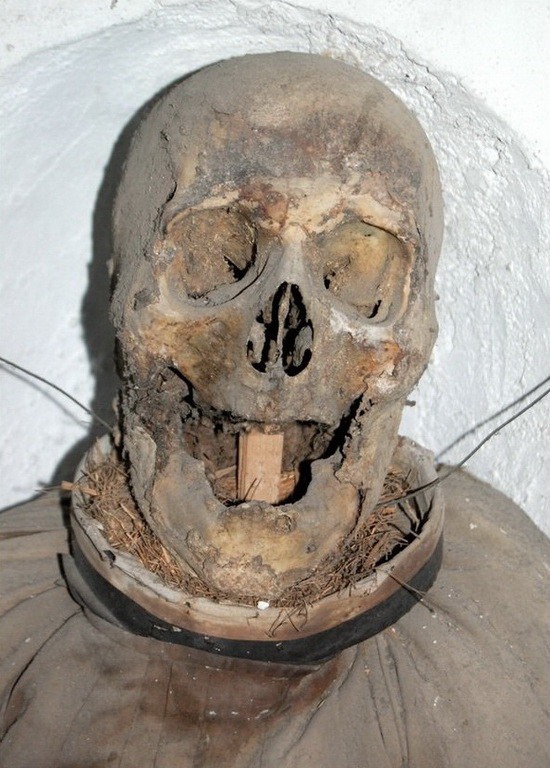Continue
heading "Post from the past" Catacombs of the Capuchins (Italian
Catacombe dei Cappuccini) - burial catacombs located in the city of Palermo in
Sicily, in which the clear remains of more than eight thousand people, most of
the local elite and prominent citizens - the clergy , the aristocracy and the
representatives of various professions. This is one of the most
famous exhibits of mummies - skeletonized, mummified, embalmed body
of the dead lie, stand, hang, form a composition.
Attention! The materials presented in this articles can seem daunting!
By the end of
the XVI century, the monks of the Capuchin monastery has increased
significantly, and there was a need for decent, spacious and versatile cemetery
for the brethren. For this purpose we adapted the crypt under the
monastery church. In 1599, there was buried brother Silvestro of Gubbio,
and then the remains were moved here several previously deceased monks. In
the future, the crypt space was cramped and the Capuchins gradually dug a long
corridor in which up to 1871 placed the body of the dead monks.
Philanthropists
and benefactors of the monastery have also expressed a desire to be buried in
the Catacombs. For their graves were dug additional corridors and
cubiculum. Up until 1739 the burial permit issued archbishops in the
Catacombs of Palermo Capuchin or managers, then - the abbot of the
monastery. In XVIII-XIX centuries, the Capuchin Catacombs became
prestigious cemetery for the clergy, the nobility and the bourgeois families of
Palermo.
Capuchin
catacombs were officially closed for burials only in 1882. For three
centuries this unique cemetery were buried about 8,000 residents of Palermo -
the clergy, monks, laymen. After 1880, for exceptional petitions in the
catacombs were laid a few of the dead, including U.S. Vice Consul Giovanni Paterniti
(1911) and a two year old Rosalia Lombardo, the incorrupt body which are the
main attractions of the catacombs.
Already in
the XVII century, it became clear that the characteristics of the soil and
atmosphere Capuchin Catacombs prevent decomposition of bodies. The main
method of preparing bodies for placement in the Catacombs was drying them in
special chambers (Collatio) for eight months.After this period, the mummified
remains washed with vinegar, clothed in the finest clothes (sometimes, according
to the wills of the body changed clothes several times a year) and placed
directly in the corridors and cubiculum Catacombs. Of the bodies were
placed in coffins, but in most cases the bodies were hung, exposed or laid in
the clear in niches or on shelves along the walls.
During
epidemics method of preserving bodies mutated: the remains of the dead were
immersed in a dilute bleach solution or containing arsenic, and after this
procedure, the body is also put on display. In 1837, the placement of bodies
in the open form was prohibited, but, at the request of testator or their
relatives, the ban avoided: the tombs were removed one wall of the left or
"windows", allowing to see the remains.
The
most famous part of the Catacombs is the Chapel of St. Rosalia (up to 1866 was
dedicated to the Virgin of sorrows). In the center of the chapel in a
glass coffin lies the body of Rosalia Lombardo two years (she died in 1920 of
pneumonia).Rosalia's father, was very upset by her death , he turned to the well-known embalmers Dr. Alfredo
Salafi with a request to keep her daughter's body from corruption. As a
result of the successful embalming, the secret of which the Salafi and has not
opened, the body remained incorrupt. Remained intact not only the soft
tissues of the face girls, but the eyeballs, eyelashes, hair.
Now the
secret of Italian scientists has been set. According to information of the
found journal Salathiel included in the formalin, alcohol, glycerol, zinc and
some other ingredients. The mixture was fed under pressure through the
artery and disperse the blood vessels throughout the body. Research
conducted in the U.S. by using embalming of Salafi gave excellent results. Burial
Rosalia Lombardo was the last in the history of the Capuchin Catacombs in
Palermo. With mummy girls associated with a number of mysterious
stories. Thirty-five years ago, the local postmaster was
crazy. According to him, he saw the girl open her eyes ...
In cubiculum
adjacent to the chapel, there is still some perfectly preserved bodies.Among
them, the body of a young man with fiery red hair, a few priests, as well as
U.S. Vice Consul Giovanni Paterniti (died in 1911), the only one buried in the catacombs
of a U.S. citizen.
For
convenience, the orientation of rooms are divided into categories: men, women,
virgins, children, priests, monks, and "profession." The
corridor of the monks is historically the most ancient part of the
Catacombs. Burials here from 1599 to 1871 years. On the right of the
current entrance of the corridor (closed to the public) placed the body 40 of
the most revered monks and people, one way or another connected with religion.
Corridor men
forms one of the two long sides of the rectangle. Here for XVIII-XIX
century placed the body of philanthropists and benefactors of the monastery of
the number of male laity. In accordance with the wills themselves buried
here and wish of their dead relatives of the body clothed in a variety of
clothing - from the rough monastic burial shroud-like garments to luxury suits,
shirts, bibs and neckties.
Cubiculum
children located at the intersection of corridors men and priests. In a
small room in a closed or open coffins, and in niches along the walls placed
the remains of several dozen children. In the central niche placed
children's rocking chair, on which sits a boy who was holding his little
sister.
Turned into
skeletons are the remains of an amazing contrast with the children's suit and
dress, lovingly selected by parents, as noted in Maupassant "Wandering
life": "... We come to the gallery full of small glass coffins: young
children. Soon became strong bones did not survive. And it is difficult to
discern that, in fact, lies in front of you, they are so disfigured, flattened
and terrible, these little kids. But the tears welling in your eyes, because
mothers dressed them in little dresses they wore in the last days of his life.
Both mothers all still come here to look at them on your children! "
Corridor
women constitutes one of the shorter sides of the rectangle. Up until 1943
the entrance to the corridor was closed by two wooden bars, and the niches with
the bodies were protected by glass. As a result of Allied bombing in 1943,
is one of the gratings and glass barriers were destroyed, and the remains
significantly damaged. Most women's bodies are placed in a separate
horizontal lie niches, and only a couple of the best-preserved bodies placed in
vertical niches.
The bodies
of women dressed in the finest clothes in the fashion XVIII-XIX centuries -
silk dress with lace and ruffles, hats and bonnets. The shocking disparity
between scattered with the remains of the time and screaming fashionable
outfits in which they are clothed, been noted by Guy de Maupassant: "This
woman is ugly even more comical than men because they have dressed up smartly.
Empty eye sockets staring at you from under the lace, decorated with ribbons
cap, framing its dazzling whiteness of the black face, eerie, rotting, corroded
decay.'s hands sticking out of the sleeves of new dresses, as the roots of the
felled trees, stockings, tight leg bones seem empty. Sometimes the dead man
alone put on shoes, his huge wretched, withered legs. "
Mostly
cubiculum, located at the intersection of corridors women and professionals, is
reserved for the burial of girls and unmarried women.About a dozen bodies lying
and standing at a wooden cross, on which is the inscription, "They are the
ones who were not defiled with women, for they are virgins are the ones who
follow the Lamb wherever he goes" (Rev.14: 4). Female heads are
topped with metal crowns as a sign of the virgin purity of the dead. The
new corridor - the new part of the Catacombs which was used after the ban put
on display the body of the dead (1837). As a result, there is no
prohibition in the hallway wall niches. All of the corridor space was
gradually (1837-1882) filled with coffins.As a result of the bombing of March
11, 1943 and a fire in 1966 most of the graves were destroyed. At present,
the surviving coffins placed along the walls in several rows, so that in the
central part of the corridor can see the floor, decorated with majolica. In
addition to the New corridor you can see several "family groups" -
the bodies of father and mother of the family with their several children,
adolescents exhibited together.
Married
couples:
Corridor
professionals, running parallel to the Corridor of men, is one of the two long
sides of the rectangle. In this corridor placed the body of professors,
lawyers, artists, sculptors, professional military. Among the notable
buried here: Filippo Pennines - sculptor, Lorenzo Marabitti - the sculptor who worked,
including, in the cathedral of Palermo and Monreale, Salvatore Manzella - a
surgeon, Francesco Enea (died 1848) - Colonel, lying in a magnificently
preserved uniform army of the Kingdom of the Two Sicilies. According to
local legend, is accepted or rejected by different researchers, professionals
in the Corridor lies the body of Spanish painter Diego Velazquez.
Brothers
artists
Capuchin
Catacombs of Palermo residents were considered as a cemetery, though
unusual. Since the XVIII-XIX centuries, burial here was a matter of
prestige, are buried in the Catacombs ancestors of many current residents of
Palermo. The catacombs are regularly visited by the descendants of those
whose bodies are found here. Moreover, after the official closing of the
Catacombs for burials (1882), the walls of the monastery was arranged by the
"usual" cemetery, so that the tradition of dumping "in the
Capuchins' continues to this day.
Portraits of
Death:











































No comments:
Post a Comment